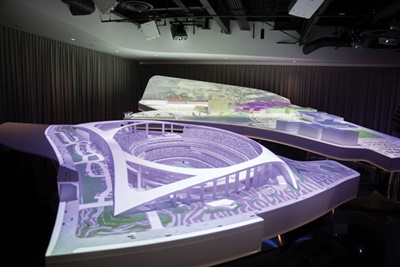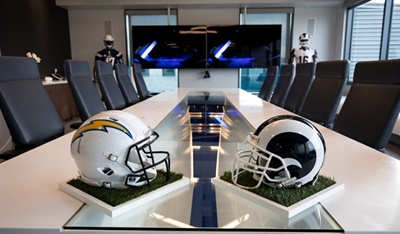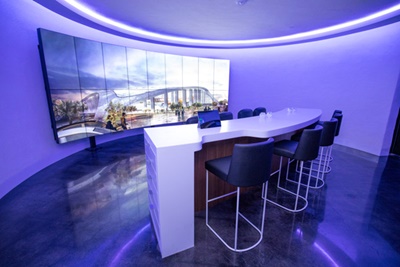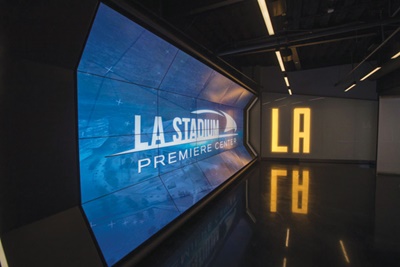 |
The $2.6 billion stadium in Inglewood, Calif., is expected to open in 2020.
Photo by: LOS ANGELES RAMS |
The next generation of stadium preview centers sits in “Silicon Beach,” the high-tech community of Playa Vista in Greater Los Angeles. It’s where the Rams and Chargers display their vision for the most expensive sports development in North America.
The L.A. Stadium Premiere Center officially opened last Thursday with dozens of appointments for suite sales, and the Rams, privately funding the $2.6 billion stadium, gave SportsBusiness Journal a sneak peek at the Premiere Center prior to this week’s big reveal.
 |
| Photo by: JEFF LEWIS |
Given the massive scope of the stadium and mixed-use district next door, a total project spanning 300 acres, developers faced the challenge of delivering the right message to potential stakeholders, whether they’re looking to buy premium seats, purchase naming rights and founding partnerships, or lease space tied to the retail and entertainment components next door.
 |
| Photo by: HIRO UENO |
“We needed to make sure we were building something that showcased [Rams owner] Stan Kroenke’s vision for the entirety of the project,” said Chris Hibbs, chief revenue officer for Legends Global Sales, the agency marketing the L.A. Stadium and Entertainment District. “It’s very much a showcase for a transformational project across
 |
| Photo by: HIRO UENO |
the L.A. region.”
Playa Vista, a hotbed for tech firms and startups, is seen as the perfect location, considering “technology is a thread that runs through everything we’re doing,” Hibbs said.
Situated on the fourth floor at the top of a building owned by tech firm Belkin International, the Premiere Center is about a 15-minute drive from the
 |
Technology plays a key role in the new stadium premiere center, where the various features and inventory are on display. One highlight is a large model (top) that showcases the stadium and mixed-use district. Overhead projectors bring the model to life.
Photo by: JEFF LEWIS |
stadium site in Inglewood and an even shorter distance from Los Angeles International Airport.
Technology plays a key role in telling the story, but it’s the touches of California flair that distinguish this project from preview centers built for the Vikings, Falcons, Dolphins and Cowboys. The ocean-wave-themed reception desk greeting visitors in the lobby on the ground floor, the open-air “discussion rooms” framed by white noise “curtains” keeping those talks private, and the outdoor deck and hospitality space facing the city that concludes the journey all brand the center with a hip, leisurely SoCal decor.
Considering the stadium doesn’t open for another three years, flexibility was a key component for the Premiere Center, which the Rams plan to operate through the opening of the NFL facility in 2020. The cost to build the Premiere Center was in the mid-seven figures, sources said.
With a heavy emphasis on digital messaging, the images and story lines can be adjusted as the stadium and mixed-use district take shape, officials said.
L.A. Stadium Premiere Center
■ Location: Belkin headquarters in Playa Vista, about five miles northwest of Inglewood
■ Cost: Mid-seven figures
■ Square footage: 20,000, including separate room for sales staff
■ Project team: Legends Global Sales, Advent, HKS, The Famous Group, RCI Builders
■ Total digital elements: 52 screens, 108 million pixels of digital “real estate,” 3.2 miles of data cable
■ The Suite Experience: IOMedia Virtual Venue technology, screens process 2.3 billion pixels per second
■ Video tunnel: 20 screens, higher resolution than Imax
■ Stadium/mixed use district model: 1,200 square feet with 12 overhead projectors
Sources: SBJ research, L.A. Rams
“The story, and the media, has to be flexible because technology and the way people consume entertainment is going to evolve,” said John Roberson, CEO of Advent, the Premiere Center’s designer.
Inside the facility, the color scheme of blue, white and steel mostly matches the hues of Rams and Chargers uniforms. After checking in at the wave desk on the ground floor, the tour starts upstairs, where visitors getting off the elevator are greeted by frosted glass doors etched with the words L.A. Stadium. Those doors open to reveal the “tunnel room,” an immersive experience featuring a curved video wall with customized content.
Depending on one’s interests, the images can be team specific, cover both teams or tell a much broader story about the entire project, Hibbs said.
Visitors then pass through a second set of frosted glass doors into a room showcasing a large white model of both the stadium and the mixed-use district. At waist high, the structure allows patrons to walk through a pathway carved in the middle of the model, splitting the stadium from the district. It’s something new in preview centers. Typically, stadium models are smaller and static. In L.A., with the touch of a button, the dozen overhead projectors bring the model to life, displaying images of players on the field, roadway traffic, even planes landing at nearby LAX.
The sales process started last week with Legends marketing the first 125 suites jointly sold for both teams. Those suites, designed in four distinct styles, sell for $300,000 to $800,000 a year, starting with 10-year terms.
All told, the stadium will hold 260-plus suites with seven distinct designs. With such a large number of suites, it made greater sense to fold it all into one digital message inside the Suite Experience, a circular-shaped room with four cushy seats and a floor-to-ceiling video screen.
It’s not a mock suite. Instead, using IOMedia’s Virtual Venue touch-screen system, Legends can take prospective buyers through every piece of suite inventory on the life-size screen.
The patio room, the final piece of the tour at the back of the Premiere Center, replicates the indoor/outdoor design of the stadium’s patio suites that spill outdoors in Inglewood. The indoor portion features a video wall displaying a live feed of the construction site. Walking outdoors, visitors take in mountain views and the city itself, and the deck can comfortably fit 100 people for meetings and receptions.
“There are a lot of spaces in the stadium where you’ll seamlessly walk from inside your club, lounge or concourse and all of a sudden you’ll be outside,” Hibbs said.
Cali style.








